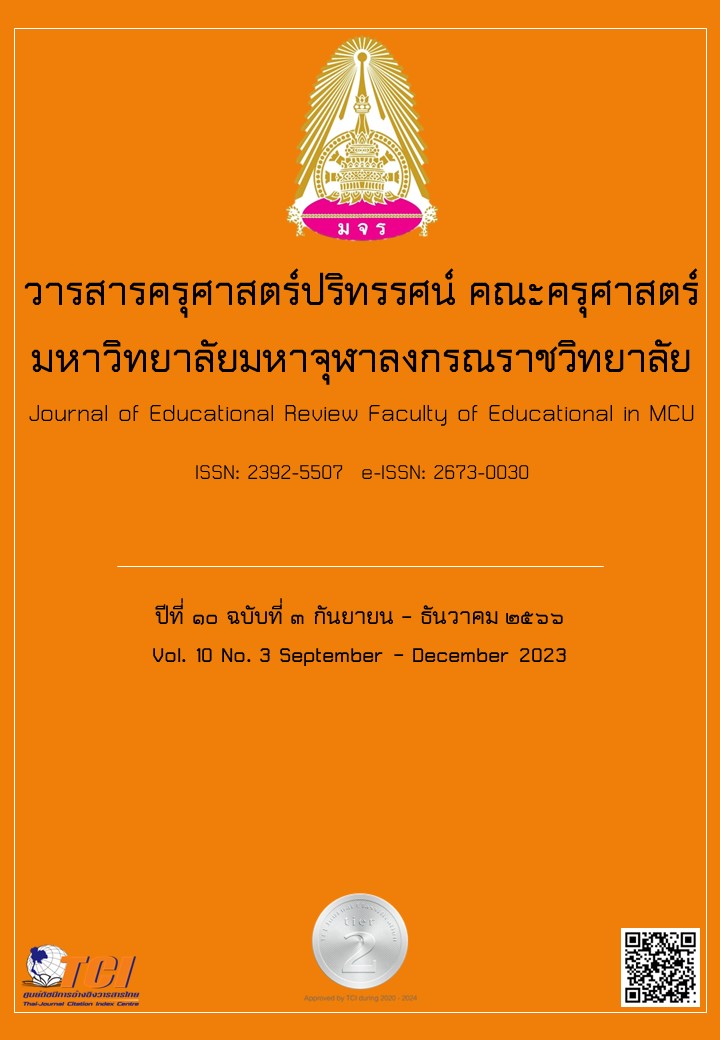THE LEARNING MANAGEMENT USING HISTORICAL METHOD WITH ONLINE MUSEUM-BASED LEARNING TO DEVELOP LOWER SECONDARY STUDENTS’ HISTORICAL THINKING SKILLS
Main Article Content
Abstract
This research article describes a pre-experimental study with two objectives. Firstly, to develop a learning management activity that enhances historical thinking skills through the use of historical inquiry and online museum learning. Secondly, to investigate the effectiveness of this activity in enhancing historical thinking skills among lower secondary students. The research sample comprised 35 third-year students from Taweethapisek School. The research instruments used in the study were a historical inquiry and online museum learning management activity, a historical thinking skills assessment with both multiple-choice and open-ended questions, and data analysis methods including mean, standard deviation, Pearson correlation coefficient, and repeated measures analysis of variance. The research findings revealed that 1) the developed historical learning activity followed the process of historical learning methods, including (1) the problem determination stage, (2) the evidence gathering stage, (3) the evidence evaluation stage, (4) the interpretation stage, and (5) the presentation stage. The focus of all stages was the students’ analysis of the primary evidence. The activities used had been evaluated by experts as very good. 2) The developed activity effectively developed history thinking skills for lower secondary school students, as evidenced by statistically significant improvements at 0.5 in the students’ scores on the history thinking skills measurement instrument. After using multivariate analysis of variance, was found that the students’ scores were significantly higher at 0.5 in all six times of measurement.
Article Details

This work is licensed under a Creative Commons Attribution-NonCommercial-NoDerivatives 4.0 International License.
ทัศนะและความคิดเห็นที่ปรากฏในบทความในวารสารฉบับนี้ถือเป็นความรับผิดชอบของผู้เขียนบทความนั้นเพียงผู้เดียว และไม่ถือเป็นทัศนะและความรับผิดชอบของกองบรรณาธิการ
กองบรรณาธิการขอสงวนสิทธิ์ในการคัดเลือกบทความลงตีพิมพ์และจะแจ้งให้เจ้าของบทความทราบหลังจากผู้ประเมินบทความตรวจอ่านบทความแล้ว
ต้นฉบับที่ได้รับการตีพิมพ์ในวารสารครุศาสตร์ปริทรรศน์ คณะครุศาสตร์ มหาวิทยาลัยมหาจุฬาลงกรณราชวิทยาลัย ถือเป็นกรรมสิทธิ์ของคณะครุศาสตร์ มหาวิทยาลัยมหาจุฬาลงกรณราชวิทยาลัย ห้ามนำข้อความทั้งหมดหรือบางส่วนไปพิมพ์ซ้ำ เว้นเสียแต่ว่าจะได้รับอนุญาตจากมหาวิทยาลัยฯ เป็นลายลักษณ์อักษร
References
เฉลิม มลิลา นิติเขตต์ปรีชา. (2559). เทคนิควิธีการสอนประวัติศาสตร์. พิมพ์ครั้งที่ 6. กรุงเทพมหานคร: สำนักพิมพ์แห่งจุฬาลงกรณ์มหาวิทยาลัย.
ชรินทร์ มั่งคั่ง. (2561). องค์ความรู้หลักสูตรและการสอนสังคมศึกษา. พิมพ์ครั้งที่ 2. กรุงเทพมหานคร: สำนักพิมพ์แห่งจุฬาลงกรณ์มหาวิทยาลัย.
ชัชพล ศิริกุล. (2559). การศึกษาผลของการจัดการเรียนรู้สาระประวัติศาสตร์โดยวิธีการทางประวัติศาสตร์ที่มีต่อทักษะการคิดอย่างมีวิจารณญาณและทักษะชีวิตของนักเรียนชั้นมัธยมศึกษาปีที่ 3. วารสารวิจัยและพัฒนา วไลยอลงกรณ์ ในพระราชูปถัมภ์. 11(2). 289-295.
ชัยรัตน์ โตศิลา. (2555). การพัฒนากระบวนการเรียนการสอนโดยใช้วิธีการทางประวัติศาสตร์เพื่อส่งเสริมทักษะการคิดทางประวัติศาสตร์ของนักเรียนมัธยมศึกษาปีที่ 2. ดุษฎีนิพนธ์ครุศาสตร์ดุษฎีบัณฑิต. จุฬาลงกรณ์มหาวิทยาลัย.
เทพปรานี ศิริวิทยารักษ์. (2532). การศึกษาปัญหาและทัศนคติต่อการเรียนการสอนวิชาประวัติศาสตร์ ส.605 ตามหลักสูตรมัธยมศึกษาตอนปลาย พุทธศักราช 2524 ของครูและนักเรียนชั้นมัธยมศึกษาปีที่ 6ของโรงเรียนในกรุงเทพมหานคร. วิทยานิพนธ์การศึกษามหาบัณฑิต.มหาวิทยาลัยศรีนครินทรวิโรฒ.
ธีระ นุชเปี่ยม. (2551). หลักฐานและวิธีการทางประวัติศาสตร์. สุทธิปริทัศน์. 22(67). 75-90.
ลัดดา ชัยหาทัพ. (2558). การศึกษาทักษะการคิดวิเคราะห์โดยการใช้วิธีการทางประวัติศาสตร์ร่วมกับผังกราฟิกรายวิชา ส 22102 ประวัติศาสตร์ของนักเรียนชั้นมัธยมศึกษาปีที่ 2. วิทยานิพนธ์ศึกษาศาสตรมหาบัณฑิต. มหาวิทยาลัยขอนแก่น.
วินัย พงศ์ศรีเพียร. (2543). ประวัติศาสตร์ไทย: จะเรียนจะสอนกันอย่างไร. กรุงเทพมหานคร: โรงพิมพ์การศาสนา.
สำนักวิชาการและมาตรฐานการศึกษา. (2554). เพื่อนคู่คิดมิตรคู่ครู: แนวทางการจัดการเรียนรู้ประวัติศาสตร์. กรุงเทพมหานคร: โรงพิมพ์ชุมนุมสหกรณ์แห่งประเทศไทย.
สุบรร พรหนองแสน, และสาคร อัฒจักร. (2563). การเปรียบเทียบผลสัมฤทธิ์ทางการเรียนและการคิดวิเคราะห์ของนักเรียนชั้นมัธยมศึกษาปีที่ 4 ระหว่างการจัดการเรียนรู้แบบโยนิโสมนสิการและการจัดการเรียนรู้วิธีการทางประวัติศาสตร์. วารสารมหาวิทยาลัยราชภัฏร้อยเอ็ด. 15(2). 113-123.
สุภัทรดิศ ดิศกุล. (2553). ประวัติศาสตร์ศิลปะประเทศใกล้เคียง: อินเดีย, ลังกา, ชวา, จาม, ขอม, พม่า, ลาว. พิมพ์ครั้งที่ 6. กรุงเทพมหานคร: มติชน.
Andrews, J. E., and Schweibenz, Werner. (1998). New Media for Old Masters: The Kress Study Collection. Art Documentation. 7(1). 19-27.
Barton, K. C., and Levstik, L. S. (2010). Why don’t More History Teacher Engage Students in Interpretation. Social Studies Today Research and Practice. 22(2). 35-42.
Burenheide, B. (2007). I can do this: Revelations on Teaching with Historical Thinking. The History Teacher. 41(1). 55-61.
Clabough, C. J. (2012). Educator’s Perceptions about the Uses of Primary Sources in Social Studies Classroom. Dissertation Ph.D. Knoxville: University of Tennessee.
Lévesque, S. (2009). Thinking Historically: Educating Students for the Twenty-First Century. Toronto: University of Toronto Press.
National Center for History in the Schools. (1996). National Standards for History: Basic Edition. Los Angeles: National Center for History in the Schools.
Nelson, R., and Drake, F. (2001). Civic Intelligence and Liberal Intelligence in the History of Social Studies Teachers and Students. Principles and Practices of Democracy in the Education of Social Studies Teachers. 15(2). 135-166.
VanSledright, B. A. (2010). What does it mean to think historically and how do you teach it?. Social Studies Today Research and Practice. 22(2). 113-120.
VanSledright, B. A. (2014). Assessing Historical Thinking and Understanding: Innovative Designs for New Standards. New York: Routledge.
Weinberg, S. (2001). Historical Thinking and Other Unnatural Acts: Charting the Future of Teaching the Past. Philadelphia: Temple University Press.
Whitesell, Emilyn Ruble. (2016). A Day at the Museum: The Impact of Field Trips on Middle School Science Achievement. Journal of Research in Science Teaching. 53(7). 1036-1054.


